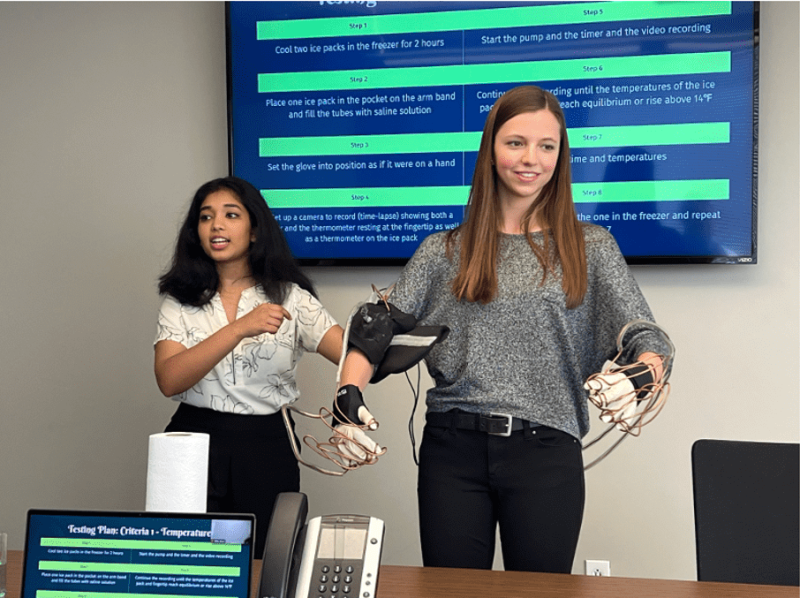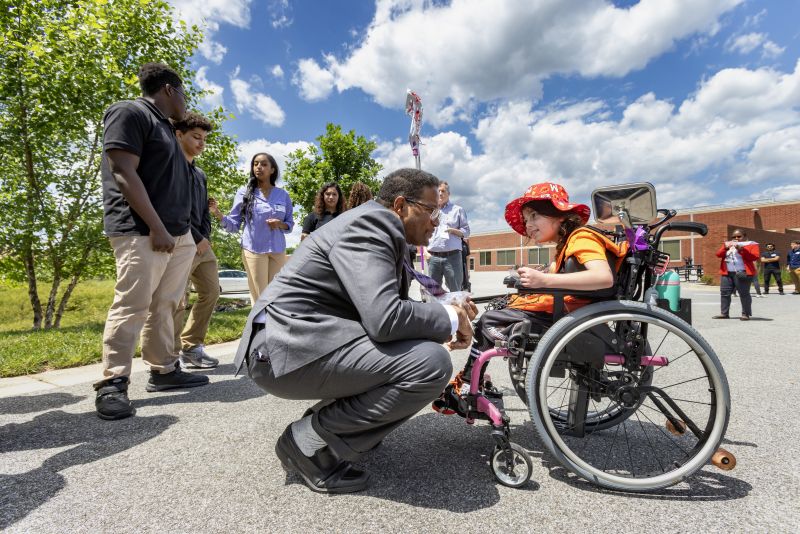NSF support puts engineering curriculum in high schools
'If you want to create, invent or build something, then this is the course for you.'
High school students take many classes that prepare them for college: English, history, physics, art, math and more. For most students, however, an engineering class is not offered at their high school, and their first exposure to engineering is in college.
Seeking to change that experience is Engineering for US All, or e4usa, an initiative to introduce engineering design principles to students in every part of the nation. Since 2018, the U.S. National Science Foundation has provided support for e4usa to create a curriculum for high schools and to train educators on effective ways to teach engineering.
"NSF has invested in e4usa because its high school curriculum helps develop students into creative thinkers and skillful designers and helps the U.S. grow a competitive engineering workforce," said Don Millard, deputy assistant director for the NSF Directorate for Engineering. "The robust approach of e4usa to engineering education also means that teachers benefit from research-based tools and methods."
Ultimately, e4usa seeks to make engineering more accessible to all U.S. high school students by establishing introductory engineering courses. The year-long courses have four main threads: connect with engineering, engineering in society, engineering professional skills, and engineering design.
"We know the material used in e4usa is effective at training teachers and students in engineering because it is based on STEM education research done by the e4usa team and other researchers," said Amelia Greer, NSF program director for e4usa. "NSF's support for this program is helping students see how exciting, flexible and creative engineering can be."
Impacts on students and teachers
e4usa courses offer students the chance to tackle compelling, real-world engineering challenges through hands-on, team-based learning. Such was the case for Ananya Varshney, then a high school student in Brentwood, Tennessee, who is now studying electrical engineering and industrial engineering at Purdue University.
"Having access to this kind of design project through e4usa truly solidified my interest in engineering," said Varshney. "I was able to develop tools for collaboration and brainstorming as well as translate skills in project management and communication to the application of an engineering solution that could improve the quality of life for cancer patients."
"My time with e4usa was instrumental in my college education," said Jacob Davis, who took the e4usa course at Plymouth Whitemarsh High School in Pennsylvania and went on to study nuclear engineering at Purdue University. "Unlike my peers, I came into college with an understanding of many of the key aspects of engineering. Not only was I a capable project solver and contributor, but I learned numerous project management skills. Those greatly contributed to my class work, where I have managed to graduate in the top of my class."
e4usa also provides educators with a roadmap and tools for teaching engineering in high school. The curriculum is already in place in more than 105 high schools, impacting more than 10,000 students.
"The e4usa course takes the guess work out of the term 'engineering' and gives you the tools and confidence to teach your students about what engineers really do," said Sharon Ball, who taught the course at Patterson High School in Baltimore, Maryland.
Many of her students were unfamiliar with engineering before taking the e4usa course. "The more we ventured through the course, the more engaged they became with doing the projects," Ball said. Her advice to students: "If you want to create, invent or build something, then this is the course for you."
Christine Zito, the applied engineering director at the Miller School of Albemarle in Charlottesville, Virginia, has been using the e4usa curriculum for five years. She has seen how e4usa reduced the perceived barriers to both teaching and learning about engineering.
"The e4usa curriculum emphasizes the technical aspects of engineering as well as writing, critical thinking and communication skills," said Zito. "As I see my students work together in teams and develop creative solutions to engineering problems, I am confident they will be better positioned for success in colleges and universities."
Smoothing the path to college
Key to increasing U.S. engineering capacity is easing the transition of students from high school to college engineering programs. e4usa and their partners believe that a well-established, effective high school engineering course can enable more students to pursue engineering as undergraduates.
Many high school students prepare for college by taking Advanced Placement (AP®) courses, which offer higher-level coursework in many U.S. high schools. AP® courses may also provide college credit if students demonstrate their proficiency on College Board AP® exams. There is no AP® course or AP® exam offered in engineering at this time.
A small group led by Leigh Abts, then an engineering professor at Johns Hopkins University, approached the College Board in 2002 about developing them. The group learned that the effort needed a common way of assessing engineering design work. With funding from NSF and the Kern Family Foundation, Abts, now at the University of Maryland, led the creation of the Engineering Design Process Portfolio Scoring Rubric (now called the MyDesign® Scoring Rubric) and the MyDesign® Learning Management System, now used by e4usa.
The effort also needed support from the deans of engineering colleges. In 2011, the American Society for Engineering Education (ASEE) Engineering Deans Council K-12 STEM Task Force took up the matter. Darryll Pines, who served on the task force while dean of the University of Maryland A. James Clark School of Engineering, eventually signed more than 120 engineering deans to the effort and led the creation of e4usa with NSF support.
"NSF understands the essential role that science and engineering education plays in workforce development," said Pines, now president of the University of Maryland. "From funding for early workshops focused on curriculum to helping e4usa develop a framework for evaluating outcomes, NSF support for e4usa will undoubtedly help democratize engineering education and make engineering more accessible for both high school students and teachers."
Since becoming an independent 501(c)(3) nonprofit organization in May 2022, e4usa has continued to grow its network of school, university and industry partners while opening new sources of funding. E4usa Executive Director Stacy Klein-Gardner, who is a biomedical engineering professor at Vanderbilt University, is working to scale the high school curriculum and teacher development with new NSF funding in 2025.
"The success of e4usa has been forwarded by the collaboration of NSF leadership and engineering deans and by learning from the experiences of high school students and teachers in rural and urban settings," said Klein-Gardner. "This broad community we are building understands the essential role engineering plays in the economy and intellectual leadership of the United States."
Today, e4usa continues to engage with engineering deans and the College Board in ongoing conversations about launching a future AP® Engineering course. This effort represents a powerful return to the initiative's roots. What began as a question about AP® Engineering sparked a broader national movement that has redefined high engineering education. Now, with growing momentum and national visibility – including a recent cover story of ASEE's magazine, Prism – e4usa is closer than ever to helping realize that original vision: an AP® Engineering course that reflects the full breadth and depth of the discipline.




